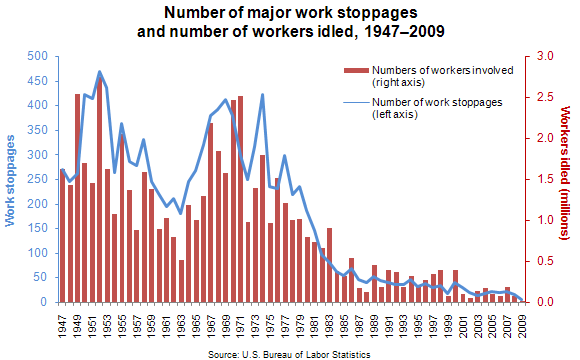The five major work stoppages in 2009 idled 13,000 workers for 124,000 lost workdays, both record lows, and a large decrease compared with 2008 with 15 stoppages idling 72,000 workers for 1.95 million lost workdays. This is according to new data released by the U.S. Department of Labor's Bureau of Labor Statistics.
Since 2007, the number of major work stoppages and the number of employees involved in major work stoppages have fallen sharply. Average annual major work stoppages have also continued to decline over the past three decades. From 2000 to 2009, there were approximately 20 major work stoppages per year, on average, compared with 35 per year from 1990 to 1999 and 83 from 1980 to 1989.
The largest work stoppage in 2009 in terms of number of days and total workdays idle was between Bell Helicopter Textron and the United Auto Workers Local 218, lasting 27 workdays with 2,500 workers accounting for 67,500 lost workdays. The largest work stoppage beginning in 2009 in terms of number of workers was between the Southeastern Pennsylvania Transportation Authority and the Transport Workers Union Local 234 with 5,500 workers involved in the work stoppage.
This data is from the BLS Work Stoppages Program. To learn more, see "Major Work Stoppages in 2009" (HTML) (PDF), news release USDL 10-0170. The major work stoppages series, which dates back to 1947, covers strikes and lockouts involving 1,000 or more employees and lasting at least one shift.





